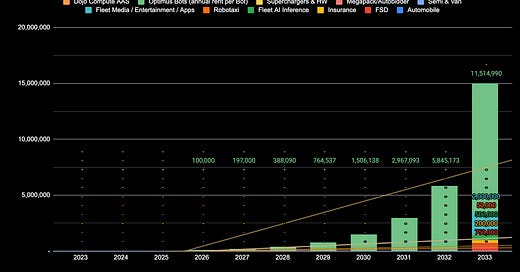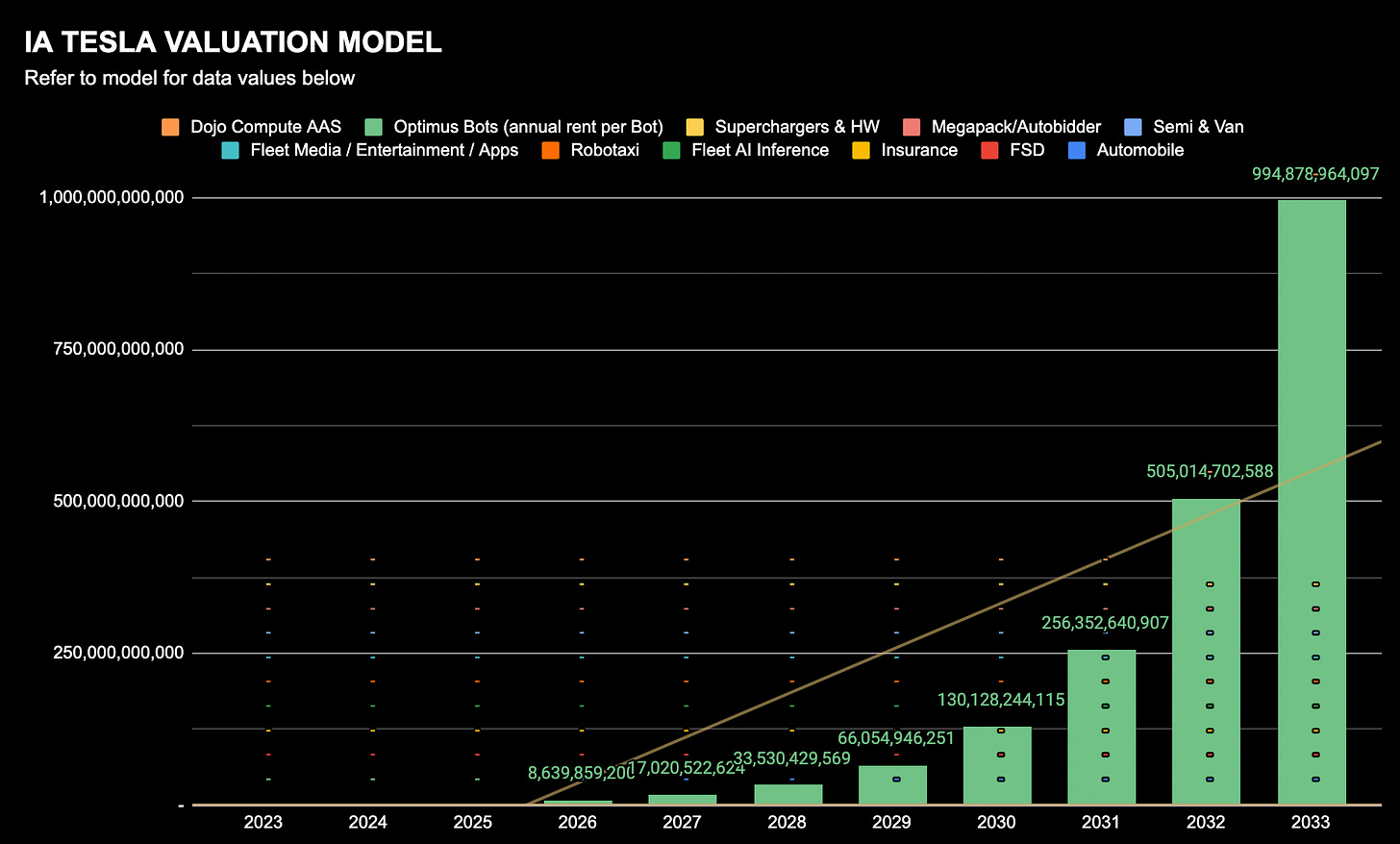Intro
This whitepaper provides an in-depth analysis of Tesla's venture into the humanoid robotics sector, focusing on its economic feasibility, market prospects, and potential to bring transformative changes. We contend that Tesla's Optimus project will be a game-changer across various industries, offering substantial financial gains and societal advancements.
In my nearly 35 years of investment experience, this represents the most significant revolution I've encountered.
Special mention goes to Chris Camillo, who appeared on Herbert Ong’s Channel and provided some of the pricing and profit data used in this study. It was interesting that Chris used the exact same PE I used when modeling this in December. Great minds!
Once again, I cross-checked Chris’s numbers into my Tesla Valuation Model, has yielded remarkable findings. Below are detailed forecasts regarding units, revenue, profit, and stock price projections.
Elon and 25% Control
Elon Musk has expressed concerns about Tesla's future in AI and robotics, particularly regarding the company's leadership in these fields. I believe he will not let Tesla become a leader in AI and robotics unless he has at least 25% voting control, which would give him significant influence in the company's decisions. Currently, Musk holds about 13% of the voting power and if you include his unvested options that would take him to 22%. So he only needs another 3%, which will easily be included in his upcoming comp plan once the Deleware court issue is settled.
It is important to stress, in my opinion, that Musk's primary concern is not financial gain but rather the ability to have a say in the future direction of Tesla in the fields of AI and robotics. He wants to ensure that his vision and ideas are considered and implemented as the company moves forward. This is particularly important to him because he believes Tesla is on the cusp of something massive.
Elon Musk's desire for 25% control in Tesla is driven by his concern for the company's future in AI and robotics. He wants to ensure that his voice has a say in the company's direction, and he believes that Tesla is on the verge of a significant breakthrough in these areas.
This paper talks about that potential.
Tesla Optimus Bot Market Potential:
Projected Demand: Anticipated demand for 1.5 million humanoids in manufacturing and logistics by 2030, driven by global job shortages and rising automation.
Financial Outlook: Projected $129 billion annual operating profit for Tesla's humanoid segment and potential valuation of $10.3 trillion by 2040.
Revenue and Profit Projections: Expected annualized gross revenue of $141 billion and operating profit of $129 billion.
TESLA UNITS PROJECTION
In terms of UNITS, based on these projections, I calculated the following:
Production and Deployment:
Cost Reduction: Projected cost decline to $20,000 - $40,000 per unit, enabling mass production and widespread adoption.
Scale Production Timeline: Deployment at scale expected by 2027.
Hourly Rate and Utilization: 16-hour daily operation at $16.88 per hour, maximizing return on investment.
Competitive Landscape and Investment Potential:
Competitive Advantage: Tesla's multi-year production and AI integration lead gives it a significant edge.
Market Underestimation: The Optimus project's potential remains largely underestimated by the market. No analysts are truly taking this seriously.
Strategic Execution and Market Dynamics:
Execution Strategy: Tesla's clear path and proven track record in innovation and manufacturing and AI bolster confidence in its execution.
Investment Timeliness: The market's recognition of the humanoid potential presents a timely investment opportunity.
Tesla will easily be manufacturing at scale by 2027
Capital Markets Advantage:
In terms of difficulties in raising capital, other competitors have challenges. Tesla does not - they could raise 10bn or 20bn at the tip of a hat. This highlights Tesla's unique advantage in this robotics sector.
Remember a tesla vehicle is a robot on wheels.
The Broader Impact of Humanoid Robots:
Technological Transformation: The potential to surpass past technological revolutions by automating complex tasks and enhancing human capabilities. We already saw this with the sorting of blocks and folding of laundry.
Impact Beyond Gains: Reshaping society, impacting job markets, ethical considerations, and advancements in diverse fields.
Risk and Reward Analysis:
Balancing Risks: While inherent risks exist, the high potential rewards outweigh them, especially for long-term investors.
Generational Opportunity: A once-in-a-generation investment chance to be part of a transformative technology.
Revenue Forecast
If the above assumptions are true - the following is my Revenue Forecast for the Optimus Bot alone
Profit Forecast
If the above assumptions are true - the following is my Profit Forecast for the Optimus Bot alone.
Stock Price Forecast
If the above assumptions are true - the following is my Stock Price Forecast for the Optimus Bot alone!
Important Note: The model employs a Price-to-Earnings (PE) ratio of 80. If the assumptions hold true and Tesla effectively implements its plans, the Bot's genuine value to Tesla Stock could reach $2,938 by 2030 and soar to $21,446 by 2033. Remember that stock markets anticipate future outcomes; these are price targets grounded in actual earnings and an 80 PE multiple.
Closing Thoughts:
In closing, we eagerly await the developments in humanoid technology over the next five years, as the field is poised to make significant strides in both functionality and integration into our daily lives. As we look forward to the future of humanoid robotics, we must also consider the broader societal implications and the importance of visionary leadership in driving this technology forward responsibly and ethically.
Tesla's venture into humanoid robots represents a pivotal moment in technological history. The potential societal impact, combined with sound financial projections and Tesla's proven execution capabilities, make the Optimus project a compelling investment opportunity and a game-changer for the future of work and technology.







